Welcome! Ready to uncover the charms of Sokcho? Tucked between the majestic Seoraksan National Park and the deep blue waters of the East Sea, this South Korean city is a sanctuary for those who love nature, seafood, and serene landscapes. Whether you’re here to hike, relax, or simply enjoy the local cuisine, Sokcho offers a picturesque backdrop to an unforgettable adventure.
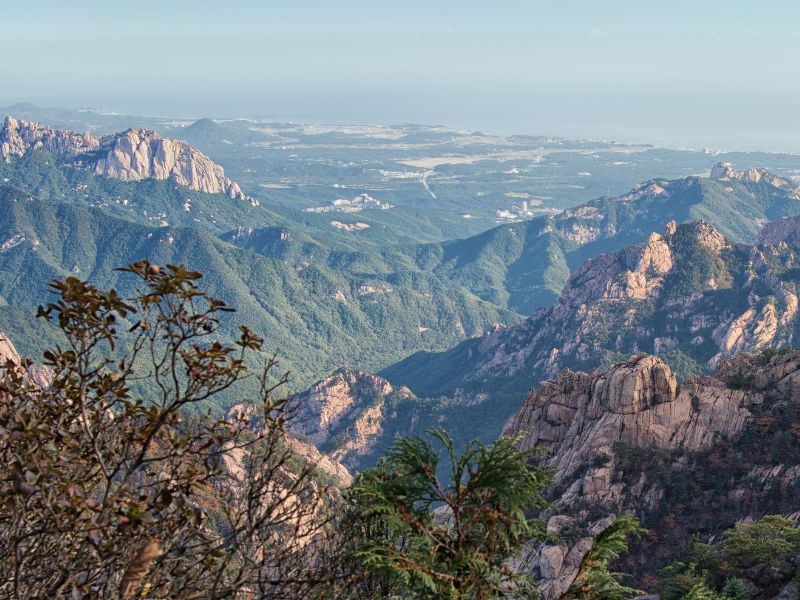
Natural Attractions
Seoraksan National Park: A Hiker’s Paradise Right on Sokcho’s doorstep lies Seoraksan National Park, famous for its dramatic peaks, lush valleys, and clear mountain streams. It’s a playground for adventurers. Hike to Ulsanbawi Rock for a panoramic view that will take your breath away, or visit the ancient Sinheungsa Temple, a tranquil spot amidst the grandeur of nature.
Beachside Bliss Want to hear the waves? Head to Sokcho Beach where golden sands meet clear waters. It’s ideal for a summer swim or a leisurely evening stroll. As the sun sets, the fading light paints the sky in hues of orange and pink—a perfect day ends here.
Culinary Journey
Sokcho’s Seafood Delight No trip to Sokcho is complete without indulging in the local seafood. At the bustling Sokcho Fish Market, pick your favorite from freshly caught fish and have it prepared on the spot. Whether it’s grilled, stewed, or served raw, the flavors are as fresh as the ocean breeze.
Local Brews and Snacks Grab a seat at a local café and sample some squid sundae, a unique Korean sausage made of squid and various fillings. Pair it with a cup of traditional Korean tea for the full experience. Sokcho’s culinary scene is a delightful mix of tradition and local taste!
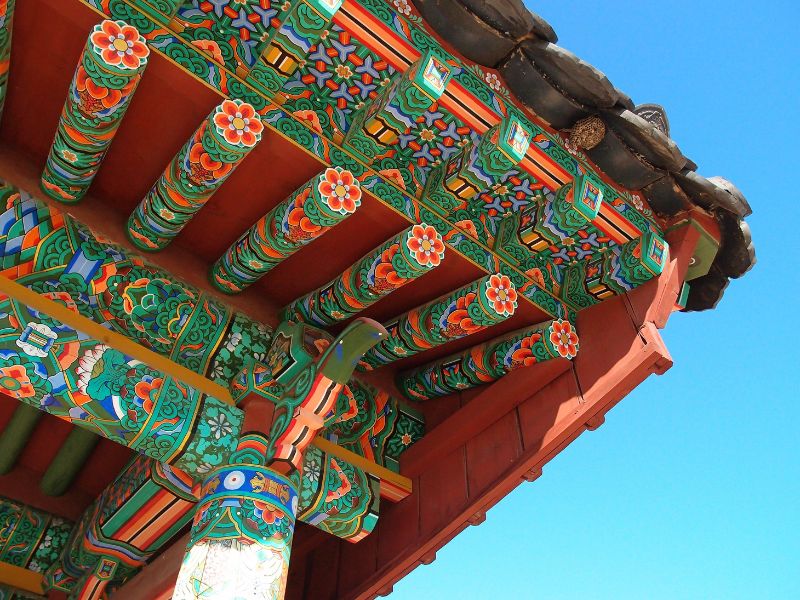
Cultural Discoveries
Glimpse into History Visit the Sokcho City Museum and Folk Arts Pavilion to dive deep into the region’s history and culture. The exhibits showcase everything from ancient artifacts to modern art, illustrating the city’s journey through time.
Festivals and Fun Plan your visit during the Sokcho International Seafood Festival or the Seorak Cultural Festival for a taste of local life. These events offer a wonderful opportunity to mingle with locals, enjoy live performances, and sample regional cuisine.
Why Sokcho? Sokcho is not just a stopover; it’s a destination. With its rich blend of natural beauty, culinary delights, and cultural heritage, Sokcho invites you to step off the beaten path and explore its many wonders. Pack your bags, bring your camera, and prepare for an adventure that will fill your soul and your photo album. Welcome to Sokcho!
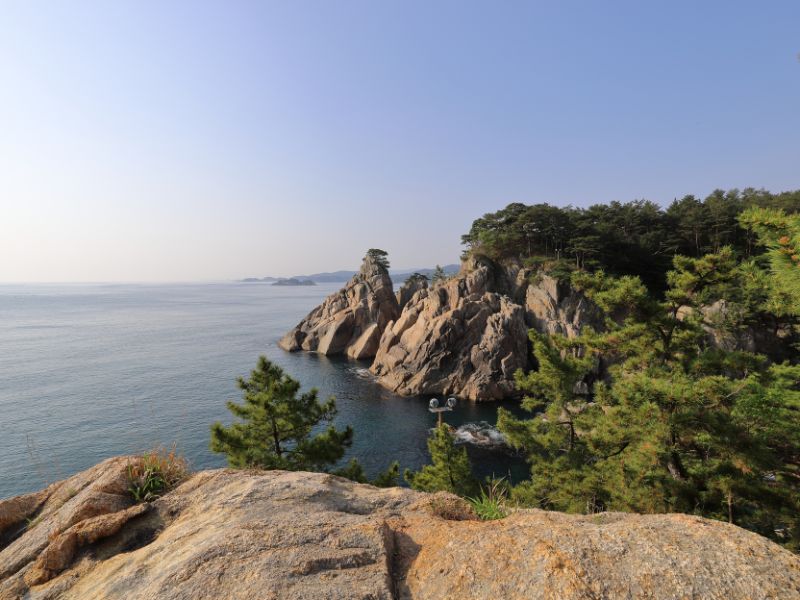
Sokcho City Guide: A Brief History Of Sokcho, South Korea
Ever wonder how Sokcho came to be? This coastal city, now known for its scenic landscapes and vibrant tourism, has a history as layered as its mountainous backdrop. Originally a small fishing village, Sokcho has witnessed many changes, evolving through the eras of war and peace, occupation, and finally, growth into the cultural haven it is today.
From Ancient Times to Modern Days
A Place of Strategic Importance Located near the border between North and South Korea, Sokcho has always been a place of strategic significance. Its history is marked by occupations—first by the Japanese during World War II, and later influenced by the proximity to the Korean Demilitarized Zone (DMZ). These historical events have shaped not only the political landscape but also the cultural and social dynamics of the city.
Post-War Evolution After the Korean War, Sokcho found itself on the southern side of the border, leading to rapid development. The city became a sanctuary for refugees from the North, bringing a diverse mix of people and cultures that influenced the Sokcho we know today. This influx led to a boom in the local economy, primarily through fishing and tourism, laying the groundwork for future prosperity.
source: Cari Cakes on YouTube
Sokcho Today
A Thriving Tourist Destination Modern Sokcho is a testament to its resilient and adaptive nature. The city has embraced its rich historical tapestry and turned its natural and historical sites into attractions that draw visitors from around the world. From the serene heights of Seoraksan National Park to the bustling docks of the fish market, Sokcho offers a unique glimpse into Korea’s natural beauty and historical complexities.
Cultural Melting Pot The influence of its diverse population is evident in the city’s cultural festivals, cuisine, and everyday life. Sokcho celebrates its history with museums and cultural centers that narrate its past, inviting tourists and scholars alike to explore its heritage.
Looking to the Future Sokcho, once a quiet fishing village, now stands as a beacon of cultural tourism and natural beauty. It’s a city that has not only survived its turbulent history but thrived by turning its trials into opportunities. Whether you’re trekking its rugged landscapes or sampling its culinary delights, Sokcho offers a deep, enriching experience that connects the past with the present.

Sokcho Top Attractions and Best Places to Visit in South Korea
Most people make the trek out to Sokcho to visit Seoraksan National Park, one of South Korea’s most beautiful nature reserves. Here, granite and gneiss peaks rise more than 1,700 metres above the surrounding landscape, giving fantastic views in every direction.
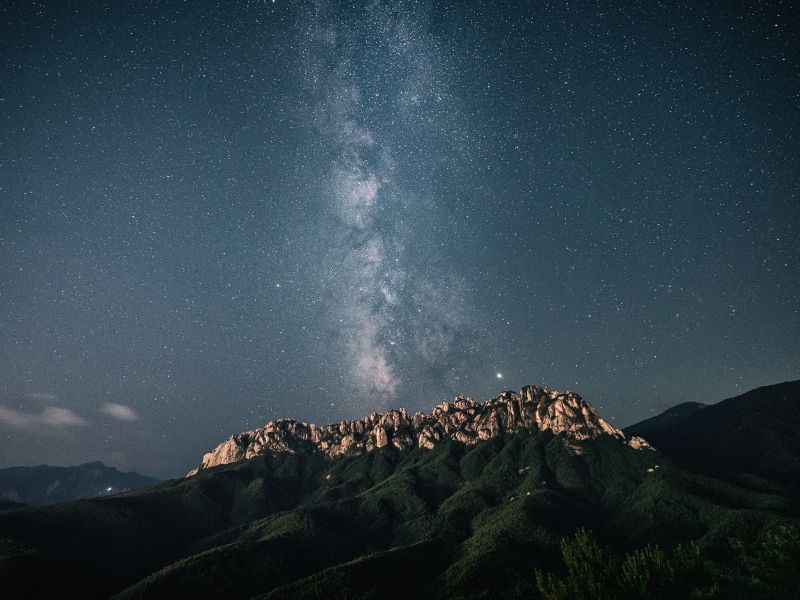
If you are short on time, ensure that you do the Ulsanbawi Rock hike. While it is described as ‘the StairMaster from hell’ by some trekkers, the dramatic views from the top and flora and fauna along the way will make the sweat you’ll shed worth it.
Waterfall fans will also love this park – ensure that Biryong Falls and Towangseong Falls are on your list, as these picturesque water features will take your breath away. Don’t leave Seoraksan National Park off your itinerary, as flowering trees, greenery, fall foliage, and snow make this place stunning in any season.
This national park isn’t just home to natural attractions – it also has cultural assets as well. While in the Sokcho area, make plans to visit Gwongeumseong Fortress. Built on Seoraksan Mountain by King Gojong in the 13th century, its impregnable position helped to keep the peace in the region for generations.
It sits in ruins in the present day, but that doesn’t stop tourists from visiting the site via a cable car. Want to head up the hard way? It used to be allowed, but the steep nature of the trail and sheer cliffs led to its closure, so you’ll have to ride the tram with day trippers.
More Attractions
While the foundations can be hard to pick out from the rocks at the summit of Seoraksan, the views of the surrounding area make up for it. Be ready to wait for at least a couple of hours during peak season – try to visit during the week, if possible.
The stunning natural beauty of the Sokcho region has made it the perfect place to build Buddhist halls of worship. Of them, Sinheungsa Temple stands out – built in the 7th century during the reign of Queen Jindeok, it has been destroyed numerous times over the aeons.
Sinheungsa Temple is best known for its statues – notable ones include the Bronze Jwabul Statue and four that honour former Cheonwang, or kings.
Sokcho is situated less than 100 kilometres from the North Korean border. As the first major city within easy reach of this frontier, it has become home to a substantial community of North Korean refugees during the Korean War.
The neighbourhood where they and their descendants live is popularly known as Abai Village. In a nation that had modernized rapidly over the past half-century, it stands out as a place where old Korean homes remain.
The charming nature of these streets made it a central shooting location for the K-drama, ‘Autumn in My Heart’ – key attractions include a supermarket where the lead actress worked and the boat she took to cross a nearby channel.
Hungry? Be sure to try some hamheung naengmyeon or Abai sundae – both dishes are familiar to this particular neighbourhood.
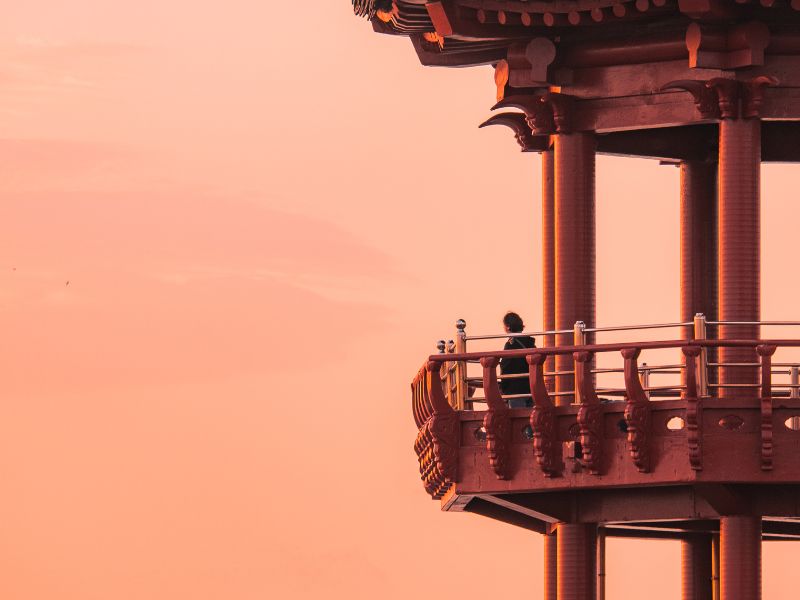
Other Cultural Attractions: Trip to Sokcho, Korea
Spent a couple of days hiking in Seoraksan with your family? Reward yourself and your kids with a relaxing day at Seorak Waterpia. A water park with indoor and outdoor features, it can be visited at any time during the year.
With water slides, wave pools, saunas, and pools that can be as hot as 49 degrees Celsius, this park is the perfect place to unwind.
Connect with locals shopping for dinner at the Sokcho Jungang Market. While it was initially a seafood market, this place has since become famous for its dak gangjeong, or sweet and sour fried chicken.
If you are jonesing for fresh seafood, though, there is no better place to go in Sokcho than Daepo Port.
Other Attractions
Here, the catch of the day is hauled off boats and is quickly prepared to be bought by restaurateurs and seafood enthusiasts.
In attached restaurants, everything from $100 fish to cheaper seafood tempura is served up – have the latter with some beer or makgeolli – thank us later.
If the peak days of summer have you drenched in sweat, seek sweet relief from the heat at Sokcho Beach. A white sand beach that extends for two kilometres (although, the public swimming area is only 450 metres wide), there are many places where you can roll out a towel to enjoy the sea breeze.
Afterwards, try some fresh sashimi, as there are countless spots along the waterfront where it is available.
source: A Couple of Nomads on YouTube
Top 30 Things To Do in Sokcho, South Korea For Visitors
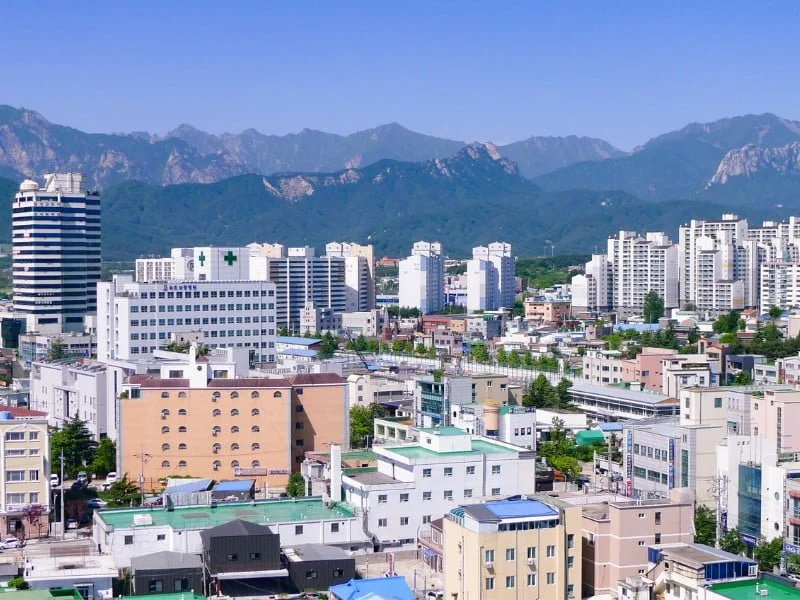
Here are the top 30 things to do in Sokcho:
1. Explore Seoraksan National Park
Dive into the natural splendor of Seoraksan National Park, renowned for its breathtaking landscapes and diverse ecosystems. With hiking trails ranging from easy strolls to challenging treks, you can explore scenic viewpoints, ancient temples, and mesmerizing waterfalls. The park is home to a rich variety of flora and fauna, including some rare species that thrill wildlife enthusiasts. Don’t miss the cable car ride to Gwongeumseong Fortress for panoramic views that will leave you in awe.
- Diverse trails: Choose from easy walks to challenging hikes.
- Stunning vistas: Capture unforgettable views from scenic viewpoints.
- Wildlife spotting: Encounter rare plants and animals in their natural habitat.
2. Visit Sinheungsa Temple
Located within Seoraksan National Park, Sinheungsa Temple is a serene Buddhist sanctuary steeped in history. The temple grounds boast a giant bronze Buddha statue, symbolizing peace and tranquility. It’s an ideal place for reflection amidst the park’s natural beauty, offering a peaceful escape from the hustle and bustle. Starting your hike from the temple also provides easy access to several scenic trails.
- Spiritual retreat: Find peace and tranquility in a historic temple setting.
- Iconic statue: Marvel at the impressive bronze Buddha.
- Gateway to trails: Easily access hiking paths from the temple grounds.
3. Enjoy Sokcho Beach
Relax and soak up the sun at Sokcho Beach, famous for its fine sand and clear waters. It’s a perfect spot for swimming, sunbathing, and engaging in various water sports. The beach offers stunning views of Seoraksan Mountain in the distance, adding to its picturesque charm. During the summer, the lively atmosphere is enhanced by numerous events and activities that keep the beach buzzing with energy.
- Beautiful sands: Enjoy soft, golden beaches perfect for relaxation.
- Water activities: Engage in swimming, jet-skiing, and more.
- Scenic backdrop: Admire the majestic Seoraksan Mountain from the shore.
4. Experience Sokcho Jungang Market
Dive into the vibrant Sokcho Jungang Market, the heart of the city’s culinary scene. Here, you can feast on fresh seafood, local snacks, and traditional Korean dishes that tantalize your taste buds. The market is also a great place to shop for unique souvenirs and interact with friendly locals. The bustling atmosphere provides an authentic glimpse into the daily lives of Sokcho’s residents.
- Fresh seafood: Savor the day’s catch prepared in delicious styles.
- Local delicacies: Try specialties like dakgangjeong and squid sundae.
- Cultural immersion: Experience the lively market vibes and local interactions.
5. Take a Stroll on Younggeumjeong Pavilion
Capture the beauty of both sunrise and sunset at Younggeumjeong Pavilion, perched on a rocky outcrop overlooking the sea. It’s a peaceful spot perfect for photography and relaxation, offering stunning views of the horizon. The pavilion is connected to Sokcho Beach by a scenic walkway, making it easily accessible for a leisurely walk. During the lantern festival, the pavilion transforms into a magical sight with colorful lights illuminating the area.
- Panoramic views: Enjoy breathtaking vistas of the sea and sky.
- Perfect photography spot: Capture stunning images during sunrise and sunset.
- Festive atmosphere: Experience the pavilion’s charm during special events.
6. Visit Abai Village
Step into the unique Abai Village, inhabited by North Korean refugees from the Korean War. The village is renowned for its Abai Sundae (a type of Korean sausage) and other North Korean delicacies. Take a small hand-pulled ferry to reach the village and immerse yourself in its rich cultural heritage. Abai Village gained fame as a filming location for the beloved Korean drama “Autumn in My Heart,” adding to its charm.
- Cultural experience: Learn about the lives of North Korean refugees.
- Delicious cuisine: Taste traditional Abai Sundae and other local dishes.
- Scenic ferry ride: Enjoy a picturesque boat trip to the village.
7. Ride the Sokcho Cable Car
Ascend to new heights with the Sokcho Cable Car, offering a scenic journey to the top of Daepo Hill. The ride provides panoramic views of the city, the sea, and Seoraksan National Park, making it a perfect spot for memorable photos. At the summit, enjoy a leisurely walk along well-maintained trails surrounded by stunning natural beauty. The cable car experience is especially magical during sunset, when the sky is painted with vibrant colors.
- Spectacular views: Enjoy sweeping vistas from Daepo Hill.
- Easy access: Reach high viewpoints without a strenuous hike.
- Sunset magic: Witness breathtaking sunsets from the cable car.
8. Explore the Sokcho Lighthouse Observatory
Discover the Sokcho Lighthouse Observatory, offering some of the best views of Sokcho’s coastline and the East Sea. Accessible via a picturesque walk along the breakwater, the observatory is a prime spot for watching both sunrise and moonrise. It’s a favorite location for photography enthusiasts and nature lovers alike. The observatory also provides excellent vantage points of Seoraksan Mountain, adding to its scenic allure.
- Stunning coastline views: Take in the expansive beauty of the East Sea.
- Photography haven: Capture incredible shots of sunrise and sunset.
- Peaceful ambiance: Enjoy a tranquil setting away from the city’s hustle.
9. Relax at Cheoksan Spa World
Unwind at Cheoksan Spa World, renowned for its natural hot springs and therapeutic baths. The spa offers a variety of pools, saunas, and wellness treatments designed to rejuvenate both body and mind. Located amidst beautiful mountain scenery, it provides a serene environment perfect for relaxation after a day of hiking or sightseeing. Experience traditional Korean onsen culture in a luxurious setting.
- Therapeutic hot springs: Soak in mineral-rich waters with healing properties.
- Variety of treatments: Choose from multiple pools and wellness services.
- Scenic location: Relax amidst tranquil mountain landscapes.
10. Hike to Ulsanbawi Rock
Challenge yourself with a hike to Ulsanbawi Rock, a massive granite formation within Seoraksan National Park. The trail is steep and demanding but rewards hikers with stunning panoramic views from the summit. Legend has it that the rock was transported from Ulsan to Sokcho to enhance Seoraksan’s beauty. The vista from the top encompasses both the rugged mountains and the sparkling sea, making the effort worthwhile.
- Iconic landmark: Trek to one of Seoraksan’s most famous rock formations.
- Legendary hike: Discover the folklore behind Ulsanbawi Rock.
- Breathtaking views: Enjoy expansive vistas of mountains and ocean.
11. Visit Dongmyeong Port
Immerse yourself in the bustling energy of Dongmyeong Port, a vibrant harbor known for its fresh seafood restaurants and lively fish market. Watch fishing boats come and go as you explore the array of seafood stalls offering the day’s catch. Indulge in freshly prepared dishes like grilled fish and spicy squid at one of the local eateries. The port also serves as a departure point for fishing trips and coastal cruises, adding to its dynamic atmosphere.
- Fresh seafood: Enjoy the freshest catches prepared on the spot.
- Lively market: Experience the vibrant fish market action.
- Culinary delights: Savor delicious seafood dishes in a maritime setting.
12. Explore Teddy Bear Farm
Delight in the whimsical charm of Teddy Bear Farm, where a wide variety of teddy bears are showcased in different themed settings. From historical scenes to modern-day Korea, each exhibit tells a unique story through adorable teddy bear displays. The farm also features outdoor gardens and picnic areas, making it a perfect spot for families and teddy bear enthusiasts. It’s a fun and enchanting place that brings joy to visitors of all ages.
- Adorable exhibits: Discover teddy bears in creative and charming scenarios.
- Family-friendly: Enjoy a delightful experience suitable for all ages.
- Outdoor charm: Relax in beautiful gardens and picnic spots alongside the displays.
13. Enjoy Water Sports at Yeongrang Lake
Get active at Yeongrang Lake, a scenic spot ideal for paddle boating, kayaking, and biking around its picturesque perimeter. The lake is particularly stunning in the evening when it’s illuminated by surrounding lights, creating a magical ambiance. It’s a popular recreational area for both locals and tourists looking to enjoy outdoor activities. The peaceful environment makes it a great place to relax and take in the serene beauty.
- Leisurely activities: Paddle boat, kayak, or bike around the lake.
- Evening illumination: Enjoy the enchanting light displays at night.
- Recreational fun: Engage in various outdoor sports in a beautiful setting.
14. Discover Gwongeumseong Fortress
Explore the historic Gwongeumseong Fortress, accessible by cable car or a rewarding hike. Although only ruins remain, the site offers stunning views of Seoraksan National Park and the surrounding area. Named after a legend of two generals who turned into eagles to protect the region, the fortress is steeped in folklore. The panoramic vista from the ruins provides a perfect backdrop for reflection and photography.
- Historic significance: Learn about the fortress’s legendary past.
- Scenic views: Capture beautiful panoramas of mountains and sea.
- Cultural heritage: Appreciate the blend of history and nature in one location.
15. Stroll Along Sokcho Expo Tower
Visit Sokcho Expo Tower within the Expo Memorial Park, offering panoramic views of Sokcho city, the harbor, and the surrounding mountains. The tower features an observation deck, exhibition halls, and cultural performance spaces, making it a versatile destination. The park itself is beautifully landscaped with sculptures and themed gardens, providing a pleasant environment for a leisurely walk. It’s a landmark that commemorates Sokcho’s hosting of the International Fisheries Expo.
- Observation deck: Enjoy sweeping views from the top of the tower.
- Cultural events: Attend exhibitions and live performances within the tower.
- Beautiful surroundings: Stroll through landscaped gardens and artistic displays.
16. Visit Daepo Port
Daepo Port is a must-visit for seafood aficionados, known for its lively fish market and numerous seafood restaurants. Here, you can buy fresh seafood and have it cooked to perfection at one of the nearby eateries. The port also serves as a departure point for fishing trips and coastal cruises, offering a taste of local maritime culture. It’s an authentic experience that highlights Sokcho’s connection to the sea.
- Fresh seafood: Enjoy the day’s catch prepared in delicious styles.
- Market exploration: Browse through the bustling fish market for unique finds.
- Maritime culture: Experience the vibrant life of a busy harbor.
17. Hike Biryong Falls Trail
Embark on a hike to Biryong Falls, a stunning waterfall nestled within Seoraksan National Park. The trail is moderately easy, making it accessible for most hikers, and leads you through lush forests and alongside crystal-clear streams. Upon reaching the falls, you’ll be rewarded with the sight of cascading water plunging into a serene pool below. It’s a perfect spot for a refreshing break and some memorable photos.
- Beautiful waterfalls: Witness the majestic Biryong Falls up close.
- Nature trail: Enjoy a scenic hike through dense forests and streams.
- Photography opportunities: Capture the stunning natural beauty of the falls.
18. Explore Oeongchi Beach
Discover the dramatic beauty of Oeongchi Beach, renowned for its coastal cliffs and clear waters. It’s a quieter alternative to Sokcho Beach, offering a peaceful retreat with stunning views. The beach is perfect for rock fishing, providing a unique way to enjoy the sea. The walking path along the cliffs offers spectacular views, making it a favorite spot for photographers and nature lovers.
- Dramatic scenery: Enjoy stunning coastal cliffs and pristine waters.
- Peaceful retreat: Escape the crowds and relax in a serene environment.
- Unique activities: Try rock fishing for a different beach experience.
19. Enjoy Sokcho City Museum and Displaced Civilians Folk Village
Gain a deeper understanding of Sokcho’s history at the Sokcho City Museum and Displaced Civilians Folk Village. These sites offer insights into the lives of displaced civilians during the Korean War, showcasing exhibits and reconstructed homes that highlight resilience and cultural heritage. It’s an educational and poignant experience that honors the past while celebrating the spirit of the Korean people. Traditional crafts and food demonstrations are occasionally available, enhancing the cultural immersion.
- Historical insights: Learn about the impact of the Korean War on Sokcho.
- Cultural exhibits: Explore reconstructed homes and traditional crafts.
- Educational experience: Engage with informative displays and stories of resilience.
20. Visit the Seorak Waterpia
Cool off and have fun at Seorak Waterpia, a popular water park offering a variety of pools, slides, and spa facilities. Set against the backdrop of Seoraksan Mountain, the park provides a refreshing escape during the summer months. It’s perfect for families looking to enjoy a day of water-based activities and relaxation. The park also features hot spring baths, allowing visitors to unwind and rejuvenate after a day of fun.
- Water slides and pools: Enjoy a variety of fun and exciting water attractions.
- Relaxing spa: Soak in hot spring baths for ultimate relaxation.
- Scenic location: Benefit from beautiful mountain views while you play.
21. Walk Through Sokcho Central Market
Immerse yourself in local life at the bustling Sokcho Central Market. Here, you can explore a wide range of goods, from fresh produce and seafood to traditional Korean street food and souvenirs. The market is particularly famous for its dakgangjeong (sweet and crispy chicken), a must-try delicacy for any food lover. The lively atmosphere provides an authentic cultural experience and a perfect place to shop for unique items.
- Diverse offerings: Find everything from fresh seafood to handcrafted souvenirs.
- Delicious street food: Taste local favorites like dakgangjeong and more.
- Vibrant atmosphere: Experience the energy and hustle of a traditional Korean market.
22. Explore Seorak Cinerama
Enhance your understanding of Seoraksan National Park at Seorak Cinerama, a unique attraction offering immersive documentary screenings. These high-definition films provide an in-depth look into the park’s ecology, wildlife, and stunning landscapes, making you feel as though you’re exploring the park firsthand. It’s an educational experience that complements your outdoor adventures, perfect for those unable to hike the trails. The captivating visuals and informative narratives make it a must-visit for nature enthusiasts.
- Immersive documentaries: Watch stunning films that showcase Seoraksan’s beauty.
- Educational insights: Learn about the park’s ecology and conservation efforts.
- Complementary experience: Enhance your visit with informative visual storytelling.
23. Visit the Sokcho Butterfly Museum
Step into the enchanting world of butterflies at the Sokcho Butterfly Museum. This delightful museum is dedicated to the preservation and display of various butterfly species, offering an educational experience about their life cycles and habitats. Wander through beautifully maintained gardens where live butterflies flutter freely, adding to the museum’s charm. It’s a peaceful and magical destination for nature lovers and families alike.
- Beautiful displays: See a wide variety of butterfly species up close.
- Educational exhibits: Learn about butterfly life cycles and habitats.
- Enchanting gardens: Enjoy walking through gardens teeming with butterflies.
24. Enjoy Golf at Seorak Plaza Country Club
Tee off amidst stunning natural scenery at the Seorak Plaza Country Club, offering a premier golfing experience with well-maintained greens set against the backdrop of Seoraksan National Park. The club provides a challenging yet enjoyable course for golfers of all skill levels, ensuring a great time whether you’re a beginner or a seasoned pro. After your game, relax at the clubhouse with excellent facilities and dining options. It’s a perfect blend of sport and nature, making it a must-visit for golf enthusiasts.
- Beautiful courses: Play golf with breathtaking views of mountains and forests.
- All skill levels: Courses designed to cater to both beginners and experienced golfers.
- Relaxing amenities: Enjoy top-notch facilities and delicious meals at the clubhouse.
25. Try Local Delicacies at Dongmyeong Port
Savor the freshest seafood at Dongmyeong Port, a bustling harbor area known for its lively fish market and array of seafood restaurants. Here, you can purchase fresh catches and have them prepared to perfection at one of the local eateries, offering a true taste of Sokcho’s maritime culture. It’s an ideal spot for foodies looking to indulge in authentic Korean seafood dishes. The vibrant atmosphere and scenic waterfront make dining here a memorable experience.
- Fresh seafood: Enjoy the day’s catch cooked just for you.
- Authentic dining: Taste traditional Korean seafood specialties.
- Vibrant setting: Experience the lively atmosphere of a working harbor.
26. Kayak in the East Sea
Discover Sokcho’s stunning coastline from a different perspective by kayaking in the East Sea. Paddle through clear waters and explore hidden coves, rocky shores, and pristine beaches that are otherwise inaccessible by land. Guided tours are available for both beginners and experienced kayakers, ensuring a safe and enjoyable adventure. It’s a peaceful and invigorating way to connect with nature and admire Sokcho’s natural beauty up close.
- Scenic paddling: Navigate through picturesque coastal landscapes.
- Accessible adventure: Suitable for all skill levels with guided options.
- Nature exploration: Discover hidden gems and serene spots along the coast.
27. Visit the National Mountain Museum
Enhance your knowledge of Korea’s majestic mountains at the National Mountain Museum in Sokcho. Dedicated to the mountains of Korea, with a special focus on Seoraksan, the museum features exhibits on mountaineering, ecology, and the cultural significance of mountains in Korean heritage. Interactive displays and educational programs make it an engaging visit for both adults and children. It’s a must-visit for anyone interested in the natural and cultural aspects of Korea’s mountainous landscapes.
- Educational exhibits: Learn about mountaineering and mountain ecology.
- Cultural insights: Discover the significance of mountains in Korean traditions.
- Interactive displays: Engage with hands-on exhibits and informative presentations.
28. Relax at Cheongchoho Lake
Take a break from sightseeing and unwind at Cheongchoho Lake, a serene spot perfect for leisurely walks, biking, and picnicking. The lake is surrounded by walking paths and lush greenery, providing a tranquil environment to relax and enjoy the natural beauty. It’s also a popular location for bird watching, offering a peaceful retreat for nature lovers. Nearby cafes and restaurants allow you to enjoy a snack or meal while taking in the scenic views.
- Peaceful walks: Enjoy leisurely strolls around the calm lake.
- Outdoor activities: Bike, picnic, or watch birds in a serene setting.
- Cafes and eateries: Relax with a drink or meal by the water’s edge.
29. Experience the Sokcho Lighthouse Observatory
Gain breathtaking panoramic views from the Sokcho Lighthouse Observatory, a top spot for photography and nature appreciation. Situated on a hill, the observatory offers expansive views of Sokcho city, the harbor, and the surrounding mountains. It’s an ideal location for watching both sunrise and sunset, providing stunning light conditions for memorable photos. The observatory is easily accessible via a pleasant walk along the breakwater, making it a must-visit landmark in Sokcho.
- Panoramic views: Capture sweeping vistas of the city and sea.
- Photography hotspot: Perfect for stunning sunrise and sunset shots.
- Easy access: Reach the observatory via a scenic walk.
30. Adventure at Seoraksan Sogongwon Cable Car
Embark on an adventurous journey with the Seoraksan Sogongwon Cable Car, offering a breathtaking ride to the Gwongeumseong Fortress area. The cable car provides stunning aerial views of Seoraksan’s rugged terrain and lush forests, making the journey as exciting as the destination. Upon arrival, explore the area’s scenic spots without the need for a strenuous hike. The cable car ride is a highlight for many visitors, offering unforgettable views throughout the year.
- Scenic ride: Enjoy aerial views of Seoraksan’s natural beauty.
- Easy access: Reach high viewpoints without a challenging hike.
- Year-round attraction: Experience the stunning landscape in every season.

What to Eat and Drink at Restaurants in Sokcho, South Korea
Here’s a comprehensive guide to the must-try foods and drinks when visiting Sokcho, ensuring you savor the flavors that define this unique region.
Seafood Specialties
1. Grilled Fish (Gui)
- What to Expect: Freshly caught fish from the East Sea, grilled to perfection over an open flame.
- Popular Choices: Mackerel and squid are local favorites, often served with a side of spicy kimchi.
- Where to Try: Head to Daepo Port, where you can choose your fish and watch it grilled right in front of you.
2. Raw Fish (Hoe)
- What to Expect: Thinly sliced raw fish, similar to sashimi, typically served with soy sauce and wasabi.
- Serving Style: Often accompanied by a hot bowl of spicy soup to balance the cold dish.
- Where to Try: Sokcho Fish Market offers the freshest selections, direct from the sea.
Local Delicacies
3. Dakgangjeong (Sweet and Crispy Chicken)
- What to Expect: Bite-sized chicken pieces coated in a sweet, slightly spicy sauce, deep-fried to crispy perfection.
- Popular Variations: Some restaurants add nuts or green onions for extra texture and flavor.
- Where to Try: Find this popular snack at street food stalls and local markets throughout the city.
4. Sundubu-jjigae (Soft Tofu Stew)
- What to Expect: A hot and hearty stew made with silky soft tofu, seafood, and vegetables in a spicy broth.
- Serving Style: Typically served bubbling hot in a stone pot with a side of rice.
- Where to Try: Visit the Abai Village area, known for its traditional Korean restaurants.
Street Food Favorites
5. Hotteok (Sweet Korean Pancake)
- What to Expect: A warm, fried pancake filled with a sweet mixture of cinnamon, honey, and nuts.
- Ideal For: A quick snack while exploring Sokcho’s attractions or as a comforting dessert.
- Where to Try: Look for food carts along Sokcho Beach, especially during the evening.
6. Ojingeo-twigim (Fried Squid)
- What to Expect: Squid cut into rings or long strips, battered, and deep-fried until golden.
- Serving Style: Often served in paper cups as a convenient, on-the-go snack.
- Where to Try: Street vendors near the main tourist spots usually offer the freshest options.
Refreshing Beverages
7. Makgeolli
- What to Expect: A traditional Korean rice wine, slightly sweet, milky, and effervescent, typically enjoyed in a bowl.
- Pairing Suggestion: Delicious with spicy Korean dishes, as it helps soothe the palate.
- Where to Try: Local dining spots often serve home-brewed versions that are a must-try.
8. Bokbunja-ju (Black Raspberry Wine)
- What to Expect: A sweet, fruity wine made from local black raspberries, known for its deep, rich flavor.
- Health Benefits: Often consumed for its health benefits, including improved circulation and vitality.
- Where to Try: Specialty wine shops or traditional Korean bars (‘jumak’) often offer a variety of berry wines.
source: Kieun Choi on YouTube
Tips for Dining in Sokcho
- Seasonal Offerings: Ask for the seasonal specialties when visiting restaurants, as Sokcho’s menus change with the fishing seasons.
- Explore Beyond the Center: Venture into the smaller streets and neighborhoods to find hidden gems where locals dine.
- Market Dining: Don’t miss out on experiencing a meal at the Sokcho Central Market, where you can enjoy a vibrant atmosphere and taste a bit of everything from various food stalls.
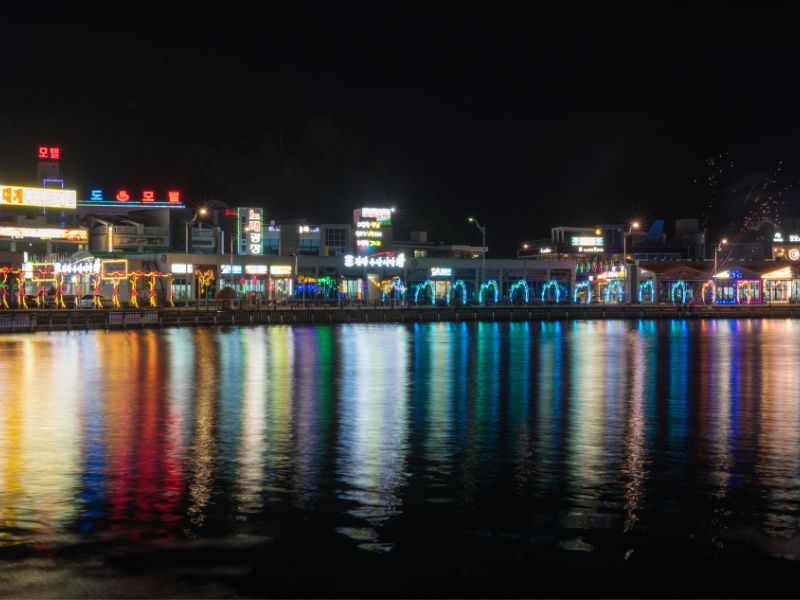
Tours For Visitors To Sokcho, Korea
Here’s a full list of the best tours available in Sokcho, ensuring that you get the most out of your trip.
1. Seoraksan National Park Hiking Tours
- Overview: These guided hikes cater to various fitness levels and take you through some of Seoraksan’s most breathtaking paths.
- What to Expect: Enjoy the flora and fauna, panoramic mountain views, and historic temples nestled within the park.
- Duration: Options range from half-day treks to full-day expeditions.
- Why Go: A knowledgeable guide enhances the experience by sharing insights about the park’s history and ecology.
2. Cultural Heritage Tours
- Overview: Explore Sokcho’s rich history through visits to ancient temples, traditional villages, and historical sites.
- What to Expect: Stops typically include the ancient Gwongeumseong Fortress, Sinheungsa Temple, and the historical Abai Village.
- Duration: Half-day or full-day tours.
- Why Go: These tours offer a deep dive into the cultural tapestry that shapes Sokcho, providing context to the city’s historical and cultural landmarks.
3. Sokcho City Food Tours
- Overview: Taste your way through Sokcho’s culinary scene with visits to popular eateries and hidden local spots.
- What to Expect: Sample dishes like sundubu-jjigae (soft tofu stew), fresh seafood, and the famous Sokcho chicken.
- Duration: 3 to 4 hours.
- Why Go: Perfect for foodies looking to explore the local flavors under the guidance of an expert who can share the backstory and ingredients of each dish.
4. Fishing and Marine Life Tours
- Overview: Get a hands-on experience with Sokcho’s fishing culture on a chartered boat tour.
- What to Expect: Opportunities to catch fish and possibly prepare and eat your catch, guided by local fishermen.
- Duration: Half-day tours available.
- Why Go: It’s a unique chance to learn about the marine life of the East Sea firsthand and enjoy freshly caught seafood.
5. Photography Tours
- Overview: These tours are designed to help you capture the best of Sokcho’s landscapes and urban scenes, guided by professional photographers.
- What to Expect: Visit the most photogenic spots at the right times of day for the best light, including Seoraksan National Park and Sokcho Beach.
- Duration: From sunrise or sunset shoots to full-day tours.
- Why Go: Ideal for amateur or professional photographers looking to add stunning images to their portfolio.
6. Eco and Wildlife Tours
- Overview: These tours focus on the rich biodiversity of Sokcho, including bird watching and nature walks.
- What to Expect: Explore habitats of local wildlife and learn about conservation efforts in the area.
- Duration: Typically half-day to full-day tours.
- Why Go: Great for nature lovers and families interested in learning more about the environmental aspects of Sokcho.
7. Adventure Sports Tours
- Overview: For those looking for a thrill, Sokcho offers a variety of adventure sports tours.
- What to Expect: Activities include paragliding, zip-lining, or mountain biking in areas surrounding the city.
- Duration: Varies depending on the activity; typically half-day.
- Why Go: Experience the natural beauty of Sokcho from unique vantage points and get an adrenaline rush at the same time.
8. Relaxation and Wellness Tours
- Overview: These tours combine visits to local spas and wellness centers with relaxation techniques and treatments.
- What to Expect: Sessions may include traditional Korean spa experiences, meditation, and therapeutic walks.
- Duration: Half-day to full-day options.
- Why Go: Perfect for unwinding and rejuvenating while exploring the cultural practices of Korean wellness.
Tips for Booking Tours in Sokcho
- Advance Booking: Many tours, especially those that are highly specialized, require advance booking to ensure availability.
- Local Operators: Consider booking through local tour operators to ensure that you have an authentic and high-quality experience.
- Check Reviews: Look up reviews and ratings to choose the best experiences based on past visitors’ feedback.
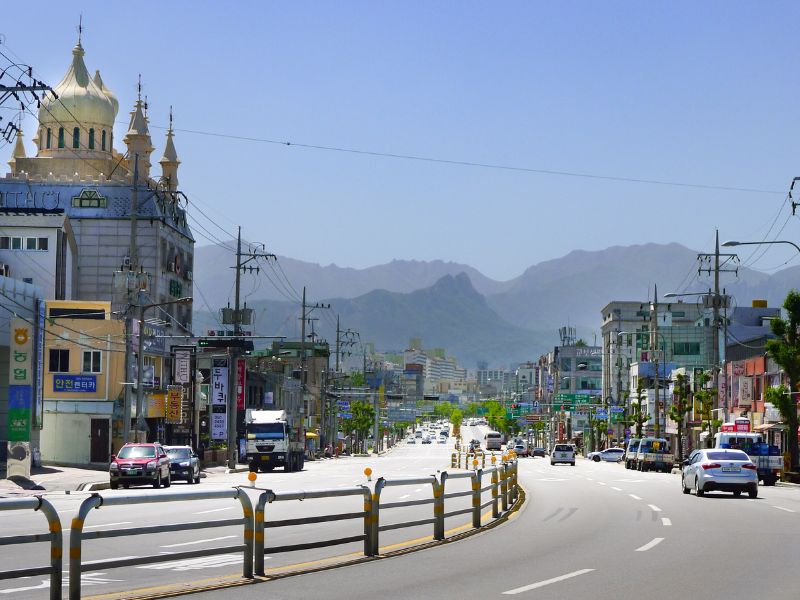
Sokcho Accommodations Guide: Hotels, Guesthouses and Hostels
Here’s a detailed travel guide to some of the best places to stay in Sokcho.
Hotels
1. Seorak Kensington Stars Hotel
- Location: Near Seoraksan National Park
- Features: This hotel offers elegant rooms with views of the Seoraksan mountains, a gourmet restaurant serving Korean and Western cuisine, and easy access to the park.
- Ideal for: Travelers looking for comfort and proximity to outdoor activities.
- Unique Perk: Themed rooms that capture the local culture and landscape.
2. Hanwha Resort Seorak Sorano
- Location: Central Sokcho
- Features: Spacious resort-style accommodations with modern amenities, including a water park, spa, and dining options.
- Ideal for: Families and groups seeking a fun and relaxing stay.
- Unique Perk: On-site water park and proximity to local attractions.
3. Lotte Resort Sokcho
- Location: Sokcho Beach
- Features: Luxury suites with ocean views, an infinity pool, and multiple dining options.
- Ideal for: Those looking for a high-end beachfront experience.
- Unique Perk: Sky lounge with panoramic views of the East Sea.
Guesthouses
1. The House Hostel
- Location: Near Sokcho Express Bus Terminal
- Features: A cozy, family-run guesthouse offering a warm, friendly atmosphere with clean and comfortable rooms.
- Ideal for: Solo travelers and budget-conscious visitors.
- Unique Perk: Personalized travel advice and homemade breakfast.
2. Egg House Sokcho Guesthouse
- Location: Downtown Sokcho
- Features: Simple, clean accommodations with a communal kitchen and lounge area.
- Ideal for: Backpackers and young travelers.
- Unique Perk: Central location with easy access to public transportation and local dining.
3. Miss Lee’s Guesthouse
- Location: Near Sokcho Beach
- Features: Private and dormitory rooms in a charming setting, with a cafe and bike rentals available.
- Ideal for: Travelers looking for a quaint, beachside stay.
- Unique Perk: Beach proximity and casual vibe.
Hostels
1. James Blue Hostel
- Location: Central Sokcho
- Features: Budget-friendly, modern hostel offering both dormitory and private rooms, a shared kitchen, and social events.
- Ideal for: Young travelers and groups.
- Unique Perk: Organized tours and social gatherings for guests.
2. Sokcho & Guesthouse
- Location: Near Sokcho City Centre
- Features: A relaxed hostel with clean, comfortable rooms, communal lounge areas, and helpful staff.
- Ideal for: Budget travelers looking for a central location.
- Unique Perk: Close to major bus routes and attractions.
3. Marine Guesthouse
- Location: Close to Sokcho Beach
- Features: Offers a mix of dormitory beds and private rooms, with easy access to the beach and local markets.
- Ideal for: Beach lovers and casual travelers.
- Unique Perk: Beach gear rentals and storage for personal equipment.
Choosing the Right Accommodation
When selecting your accommodation in Sokcho, consider what type of experience you want. Are you there to relax by the beach, explore the mountains, or perhaps dive into the local culture and cuisine? Each area offers different advantages:
- Near Seoraksan: Ideal for hikers and nature lovers.
- Sokcho Beach: Perfect for those looking to unwind by the sea.
- City Centre: Great for visitors who want to soak up the urban vibe and explore on foot.

Day Trips From Sokcho, South Korea
Here are the top 10 day trips you can embark on from Sokcho.
1. Seoraksan National Park
- Description: Just minutes away from Sokcho, Seoraksan National Park is known for its breathtaking landscapes and rugged mountain peaks.
- Activities: Hike to famous landmarks like Ulsanbawi Rock or enjoy the cable car ride to Gwongeumseong Fortress for stunning panoramic views.
- Best Time to Visit: Autumn is spectacular with vibrant fall colors, but the park is a year-round destination with each season offering its own unique beauty.
- Tips: Arrive early to beat the crowds, especially during peak seasons like fall when the foliage is at its best.
2. Goseong Unification Observatory
- Description: Located at the northernmost point of South Korea’s east coast, this observatory offers a rare glimpse into North Korea.
- Activities: View North Korean territory through telescopes and explore the exhibitions detailing the Korean War and the division of Korea.
- Best Time to Visit: Clear days offer the best visibility for observing North Korean landscapes and villages.
- Tips: Don’t forget your passport; it’s required for entry into this sensitive border area.
3. Naksansa Temple
- Description: This ancient Buddhist temple, established in 671 AD, sits atop a cliff by the sea, offering peaceful ocean views.
- Activities: Explore the temple’s beautiful structures, including the seven-story stone pagoda and the giant statue of the Bodhisattva Avalokiteshvara.
- Best Time to Visit: Spring and fall are ideal for comfortable weather and fewer tourists.
- Tips: Check for cultural events or temple stays that offer a deeper understanding of Korean Buddhism.
4. Hwacheon Sancheoneo Ice Festival
- Description: This winter festival takes place in Hwacheon county, about a two-hour drive from Sokcho.
- Activities: Try your hand at ice fishing, participate in bare-hand fishing, and enjoy various ice sculptures and sled rides.
- Best Time to Visit: The festival is held in January when the ice is thick and stable.
- Tips: Dress warmly in layers and take advantage of the heated rest areas to stay comfortable throughout the day.
5. Yangyang Surfing Beach
- Description: The nearby coastal town of Yangyang offers some of the best surfing spots on the east coast of Korea.
- Activities: Take a surfing lesson, rent a board, or just enjoy the beach atmosphere.
- Best Time to Visit: Summer is the peak season for surfing, with optimal wave conditions.
- Tips: If you’re new to surfing, many local surf shops offer lessons for beginners.
6. Gangneung Coffee Street
- Description: Gangneung, a city famous for its coffee culture, hosts this unique street lined with quaint cafes each offering a distinctive coffee experience.
- Activities: Sip on specialty coffees, attend a barista workshop, or just soak in the aromatic ambiance.
- Best Time to Visit: Visit year-round, but weekends can get particularly busy.
- Tips: Try the local bean varieties and ask about the roasting processes used at different cafes.
7. Chuncheon Dakgalbi Street
- Description: Chuncheon is renowned for its dakgalbi, spicy stir-fried chicken, which you can enjoy at its famous Dakgalbi Street.
- Activities: Watch your meal being prepared right at your table and customize it with various add-ons like cheese and rice cakes.
- Best Time to Visit: Any time of year is great for dakgalbi, but evenings offer a lively atmosphere.
- Tips: Visit with a group to try a mix of different dakgalbi styles and side dishes.
8. DMZ Tour from Sokcho
- Description: Explore the Demilitarized Zone (DMZ) between South and North Korea on a guided tour that educates about the ongoing conflict.
- Activities: Visit tunnels dug by North Korea, observe life on the other side at the Dora Observatory, and explore the Third Infiltration Tunnel.
- Best Time to Visit: Tours run year-round, but booking in advance is crucial as spaces are limited.
- Tips: Bring your passport and follow all instructions given by the tour guides for a safe experience.
9. Baekdamsa Temple
- Description: Nestled in the mountains, Baekdamsa Temple offers a serene retreat where you can learn about Korean Zen Buddhism.
- Activities: Participate in a temple stay, meditate, or simply enjoy the tranquil mountain surroundings.
- Best Time to Visit: Fall provides stunning foliage views, adding to the temple’s peaceful ambiance.
- Tips: Respect the temple etiquette; speak softly, dress modestly, and turn off your phone.
10. Samcheok Marine Cable Car
- Description: Experience breathtaking views of the East Sea and the surrounding coastline on the Samcheok Cable Car.
- Activities: Enjoy the scenic ride, explore the coastal trails, and visit the nearby caves.
- Best Time to Visit: Clear days offer the best views, making spring and fall ideal times for a visit.
- Tips: Purchase tickets in advance during peak times to avoid long waits.
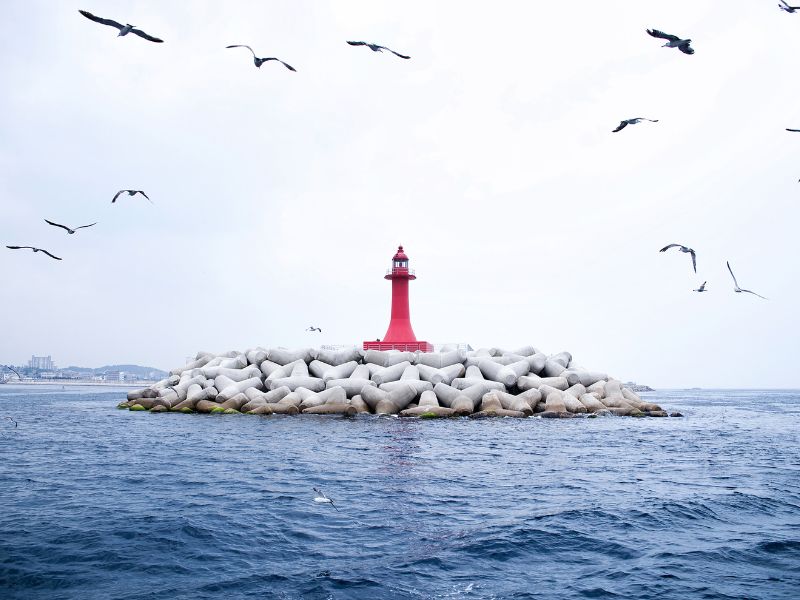
Sokcho Transportation Guide
here’s everything you need to know about getting around Sokcho.
1. Intercity Buses
- Overview: Sokcho’s intercity bus terminal connects it to major cities across South Korea, including Seoul, Incheon, and Busan.
- Features: Regular services run by several bus companies ensure that travelers can find convenient schedules.
- Cost: Prices vary depending on the destination; for example, a bus ticket to Seoul typically costs around 18,000 to 20,000 KRW.
- Tips: Booking in advance can be wise during peak travel seasons or weekends to secure a seat.
2. Local Buses
- Overview: A comprehensive network of local buses covers both the city and the neighboring areas, including Seoraksan National Park.
- Features: Affordable and reliable, these buses are a great way to move around and explore local attractions.
- Cost: A standard fare starts at about 1,200 KRW, depending on the distance.
- Tips: Have small change ready as buses do not give change, and check the latest schedules online or at bus terminals as they can change seasonally.
3. Taxis
- Overview: Taxis in Sokcho are readily available and can be hailed on the street, at taxi stands, or called via phone.
- Features: They offer a fast and convenient way to travel, especially late at night when buses may no longer be running.
- Cost: Base fare starts at around 3,300 KRW, with additional charges depending on distance and time.
- Tips: Ensure the meter is running to avoid overcharging; most drivers do not speak English, so having your destination written in Korean can help.
4. Car Rentals
- Overview: Renting a car gives you the flexibility to explore Sokcho and its surroundings at your own pace.
- Features: Several rental agencies are available at or near the bus terminal, offering a variety of vehicles.
- Cost: Daily rentals can vary widely based on the type of vehicle and rental duration, generally starting from around 55,000 KRW per day.
- Tips: International visitors will need a valid international driver’s license; be aware of local driving laws and mountainous roads.
5. Bicycles
- Overview: Sokcho is a bike-friendly city with many scenic paths, including routes along the beach and to nearby attractions like Seoraksan.
- Features: Bike rentals are available throughout the city, especially near major tourist spots.
- Cost: Rental costs are generally inexpensive, around 10,000 KRW for a full day.
- Tips: Check the condition of the bike before renting, and plan your route to include bike-friendly paths.
6. On Foot
- Overview: Walking is an excellent way to explore Sokcho, especially the beachfront and downtown areas.
- Features: Many of Sokcho’s attractions are located within walking distance from each other, particularly in the city center.
- Cost: Free!
- Tips: Wear comfortable shoes and carry a map or a GPS-enabled device to navigate easily.
7. Electric Scooters
- Overview: Recently, electric scooters have become a popular way for locals and tourists alike to navigate the city.
- Features: These scooters can be rented through apps and found in various locations around Sokcho.
- Cost: Prices are usually charged per minute, typically around 100 KRW per minute.
- Tips: Always wear a helmet, follow local traffic laws, and park the scooters in designated areas to avoid fines.
Useful Tips for Travelers
- Local Maps: Always have a current map or a GPS navigation app on your phone, as some older streets may not be well-marked.
- Language Barrier: Not all transport workers speak English, so having key phrases in Korean or a translation app can be very helpful.
- Transport Passes: Look into any available transport passes or cards that offer discounts for multiple uses across different types of transport.
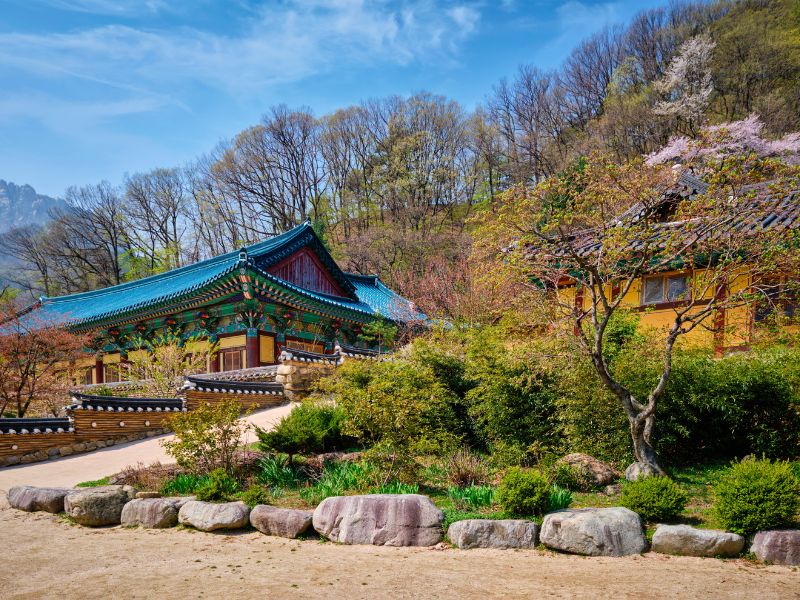
Where To Visit After Your Trip To Sokcho?
Here are ten excellent places to visit after your trip to Sokcho, each offering unique attractions and experiences.
1. Seoul
- Description: The bustling capital city of South Korea is just a few hours away and offers an exciting mix of modernity and tradition.
- Activities: Visit the historic Gyeongbokgung Palace, explore vibrant neighborhoods like Hongdae for art and fashion, and shop in the extensive Myeongdong district.
- Best Time to Visit: Spring (April-May) and fall (September-October) are ideal for pleasant weather and colorful scenery.
- Tips: Utilize Seoul’s extensive subway system to get around efficiently and affordably.
2. Gangneung
- Description: Located on the eastern coast of Korea, Gangneung is famous for its beautiful beaches and the annual coffee festival.
- Activities: Relax on Gyeongpo Beach, visit the Ojukheon House to see historical Korean architecture, and try local specialties at the Gangneung Coffee Festival.
- Best Time to Visit: Summer for beach activities and October for the coffee festival.
- Tips: Don’t miss the sunrise at Jeongdongjin, one of the earliest viewing spots on the Korean peninsula.
3. Jeonju
- Description: Known as the birthplace of bibimbap and a hub of Korean culture, Jeonju offers a charming traditional Korean experience.
- Activities: Explore the Jeonju Hanok Village with its traditional houses, enjoy a bowl of authentic Jeonju bibimbap, and visit the Jeonju Hanji Museum to learn about traditional Korean paper.
- Best Time to Visit: Spring and fall for mild weather and local festivals.
- Tips: Stay overnight in a Hanok to experience traditional Korean living.
4. Busan
- Description: South Korea’s second-largest city is famed for its dynamic coastline, vibrant nightlife, and rich history.
- Activities: Stroll along Haeundae Beach, visit the bustling Jagalchi Fish Market for fresh seafood, and explore the historic Beomeosa Temple.
- Best Time to Visit: Late spring and early fall when the weather is warm but not too hot.
- Tips: Take a day trip to nearby Gamcheon Culture Village for colorful street art and stunning city views.
5. Gyeongju
- Description: Often referred to as the “museum without walls,” Gyeongju is rich in Silla dynasty history with countless archaeological sites and cultural treasures.
- Activities: Visit Bulguksa Temple, explore the ancient tombs in Tumuli Park, and see the impressive Cheomseongdae Observatory.
- Best Time to Visit: Autumn when the weather is cool and the trees are ablaze with color.
- Tips: Rent a bike to easily explore the vast historical sites scattered around the city.
6. Incheon
- Description: Just west of Seoul, Incheon is a dynamic city known for its port, modern architecture, and the Incheon International Airport.
- Activities: Walk through Chinatown for cultural sights and great food, explore the futuristic Songdo International Business District, and relax at Wolmido Island.
- Best Time to Visit: Year-round, with cultural events and festivals happening throughout.
- Tips: Visit during the Incheon Pentaport Rock Festival in August for live music and entertainment.
7. Jeju Island
- Description: Known as the “Island of the Gods,” Jeju Island offers a stunning landscape of volcanic craters, lush green tea fields, and sandy beaches.
- Activities: Hike up Hallasan Mountain, visit the Jeju Loveland for quirky art, and explore the underground lava tubes at Manjanggul Cave.
- Best Time to Visit: Spring for the blooming flowers and fall for the harvest season.
- Tips: Renting a car is the best way to explore the island at your own pace.
8. Suwon
- Description: Just south of Seoul, Suwon is famous for its well-preserved Hwaseong Fortress, a UNESCO World Heritage site.
- Activities: Walk the fortress walls, visit the traditional Korean Folk Village for a back-in-time experience, and explore the lively markets in downtown Suwon.
- Best Time to Visit: Visit in October during the Suwon Hwaseong Cultural Festival.
- Tips: Try the local specialty, Suwon galbi (Korean short ribs), at one of the many barbecue restaurants.
9. Daejeon
- Description: As South Korea’s fifth-largest city, Daejeon serves as a hub of science and education with several universities and research institutes.
- Activities: Visit the National Science Museum, relax in Yuseong Hot Springs, and explore the local markets and nightlife.
- Best Time to Visit: Anytime, but especially vibrant during the Daejeon Science Festival in October.
- Tips: Utilize Daejeon’s subway system to navigate between attractions easily.
10. Pohang
- Description: This coastal city in the Gyeongsangbuk-do province is known for its steel industry and beautiful beaches.
- Activities: Visit the POSCO Museum to learn about the steel industry, relax on Homigot Beach, and see the sunrise at the Homigot Sunrise Plaza.
- Best Time to Visit: Summer for beach activities and New Year for the sunrise festival.
- Tips: Pohang is famous for grilled squid, a must-try while visiting the area.
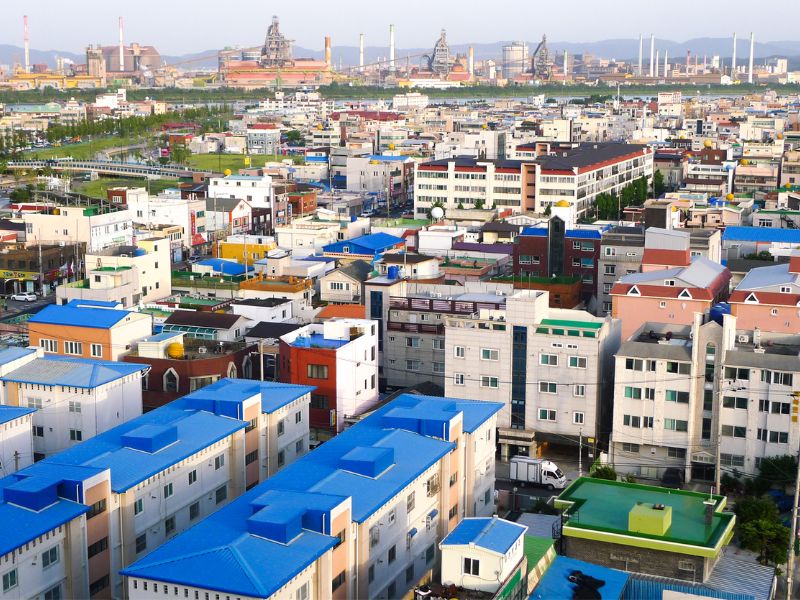
Sokcho Travel Guide: Final Thoughts
As our journey through Sokcho comes to a close, it’s clear that this city is more than just a gateway to Seoraksan National Park. It’s a place where every visit reveals new surprises and hidden gems—a seaside city that truly embodies the beauty and diversity of South Korea.
Embrace the Adventure
Nature’s Playground Whether you’ve hiked the rugged trails of Seoraksan, strolled along the pristine beaches, or simply enjoyed the panoramic views from a cable car, Sokcho offers an escape into nature that is both exhilarating and soothing. The memories of these landscapes will linger long after you’ve departed.
Culinary Delights Await
A Feast for the Senses Sokcho’s culinary scene is a paradise for food lovers. From fresh seafood straight from the East Sea to spicy local stews that warm you from the inside out, every meal is an adventure in itself. Don’t forget to grab some hotteok from a street vendor—your taste buds will thank you!
Dive into the Culture
Rich Heritage The cultural tapestry of Sokcho, with its historic temples and vibrant festivals, offers a deep dive into the traditions that shape this unique region. Participating in local celebrations or simply observing daily life in the markets can provide an authentic glimpse into the soul of the city.
Plan Your Return
More to Explore One trip is never enough to fully experience all that Sokcho has to offer. Each season brings new activities and sights, making a return trip a must. Whether it’s to catch the cherry blossoms in spring, the fiery leaves in autumn, or the snow-dusted landscapes in winter, Sokcho is a destination that calls you back time and again. Farewell, Sokcho, until next time!

Ode To Sokcho
In Sokcho, where the mountains meet the sea, A land of natural beauty, waiting for thee. With Seoraksan’s peaks and Sokcho’s beach, Adventure and relaxation are within your reach.
The Abai village, a glimpse into the past, A reminder of cultures that forever last. With fresh seafood and local delights, Your taste buds will be in for a delight.
The air is crisp, the scenery divine, The perfect place to unwind and dine. Take a hike, take a stroll, Let the wonders of Sokcho take control.
So come and visit this coastal gem, A place where memories are made, not just a whim. Sokcho welcomes you with open arms, A place of serenity and natural charms.
